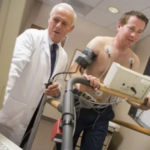
Exercise is an essential aspect of managing heart failure, a chronic condition where the heart’s ability to pump blood is weakened. While it may seem daunting to exercise with heart failure, physical activity can actually improve symptoms, strengthen the heart, and enhance overall quality of life. However, it’s crucial to approach exercise safely and effectively. In this blog, we’ll explore five tips for exercising with heart failure to help you stay active and healthy.
1. Consult Your Cardiologist
Before beginning an exercise regimen, it’s crucial to seek advice from your cardiologist. Your cardiologist can assess your heart health, determine the level of exercise that’s safe for you, and provide personalized recommendations. They may also recommend specific types of exercises based on your condition and overall health.
2. Start Slowly and Gradually Increase Intensity
If you are just beginning to exercise or returning after a long break, it’s crucial to begin at a slow pace and gradually increase the intensity of your workouts. Begin with low-intensity activities such as walking, cycling, or swimming, and gradually increase the duration and intensity as you build strength and endurance. Listen to your body and don’t push yourself too hard, especially if you experience symptoms such as shortness of breath or chest pain.
3. Focus on Aerobic Exercise
Aerobic exercise, also known as cardio exercise, is particularly beneficial for individuals with heart failure. These activities help improve cardiovascular health, strengthen the heart muscle, and enhance endurance. Some examples of aerobic exercises suitable for people with heart failure include brisk walking, stationary cycling, water aerobics, and dancing. Aim for at least 30 minutes of moderate-intensity aerobic exercise on most days of the week, as recommended by guidelines.
4. Incorporate Strength Training
In addition to aerobic exercise, strength training can also be beneficial for individuals with heart failure. Strengthening exercises help build muscle mass, improve balance and coordination, and enhance overall functional capacity. Focus on exercises that target major muscle groups, such as squats, lunges, chest presses, and bicep curls. Start with light weights or resistance bands and gradually increase resistance as you become stronger. Aim for two to three sessions of strength training per week, with a day of rest in between sessions.
5. Pay attention to your body’s signals and allow yourself to rest when needed.
One of the most important tips for exercising with heart failure is to listen to your body and take breaks as needed. Pay attention to how you feel during exercise, and if you experience symptoms such as fatigue, dizziness, shortness of breath, or chest pain, stop exercising and rest. Don’t ignore warning signs, and if symptoms persist, consult your cardiologist immediately. It’s also important to stay hydrated and avoid exercising in extreme temperatures or high humidity.
Summary
Exercise is an essential component of managing heart failure and can improve symptoms, strengthen the heart, and enhance overall quality of life. By following these five tips for exercising with heart failure, you can stay active safely and effectively. Remember to consult your cardiologist before starting any exercise program, start slowly and gradually increase intensity, focus on aerobic and strength training exercises, listen to your body, and take breaks as needed.
For personalized guidance and care in managing heart failure through exercise, consider consulting Dr. Rahul Gupta at Cardium Advanced Heart Care Clinic in Navi Mumbai. Dr. Gupta is recognized as one of the best cardiologists in Navi Mumbai, providing expert advice and support to individuals with heart failure and other cardiovascular conditions.




